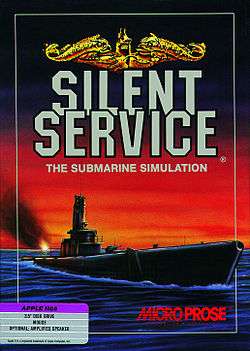Silent Service (video game)
| Silent Service | |
|---|---|
 Cover art by David Phillips | |
| Developer(s) | MicroProse |
| Publisher(s) | MicroProse |
| Designer(s) | Sid Meier |
| Artist(s) | Michael O. Haire |
| Platform(s) | Amstrad CPC, Apple II, Atari 8-bit, Atari ST, Commodore 64, Commodore Amiga, Apple IIGS, IBM PC, NES, TRS-80, ZX Spectrum |
| Release date(s) | 1985 |
| Genre(s) | Submarine simulator |
| Mode(s) | Single-player |
Silent Service is a 1985 submarine simulator video game. It was designed by Sid Meier and published by MicroProse for various 8-bit home computers, and in 1987 for 16-bit systems like the Amiga. A NES port of Silent Service developed by Rare was released in 1989 by Konami in Europe and by Ultra Games in North America. The follow-up game, Silent Service II, was released in 1990.
Tommo Inc. purchased the rights to this game and digitally publishes it through its Retroism brand in 2015.[1]
Gameplay
Silent Service is set in the Pacific Ocean during World War II, with the player assuming control of a United States submarine for various war patrols against Japanese shipping ("Silent Service" was a nickname for the US Navy's submarine force in the Pacific during World War II).
The game allows the player to choose when to attack and a whole range of realistic tactics are available, including the End Around as well as near invisibility at night (if the sub's profile is kept to a minimum). The game's realism was hampered by the simulation's inability to handle more than four projectiles at a time. This was particularly troublesome when battling multiple destroyers, since the submarine would not be able to fire if four torpedoes were already in the water.
The game accelerates real time when not in combat. Sid Meier described a number of key factors that influenced the design of the game: The size of the theater, the variety of tactical situations, and evolving technology, such as the use of surface radar and torpedoes that did or did not leave trails of bubbles on the surface—only simulations set after their real-life introduction had access to them. Tasks such as navigation, damage repair, and firing were compartmentalized into different screens to allow players access to a great deal of information, but also focus on the task at hand.[2]
Reception
Silent Service was MicroProse's second best-selling Commodore game as of late 1987.[3] Compute! wrote in 1986 that "like F-15 Strike Eagle, Silent Service is both intriguing and addicting ... a superior product".[4] Computer Gaming World that year called Silent Service "easily the best [submarine simulator] for its simplicity of use and execution". It praised the game's realism and only criticized the lack of a save game feature.[5] A 1987 overview of World War II simulations in the magazine rated the gave five out of five points, praising its "superb graphics coupled with detailed rules, historical accuracy and layers of complexity".[6] In 1993 a survey of wargames gave the game two stars out of five, stating that "it has been rendered obsolete by time and superseded by Silent Service II".[7] In 1996, Computer Gaming World ranked it as the 86th best game of all time for having "introduced the control-room interface for submarine games on variety of platforms."[8]
References
- ↑ "Purchase Agreement between Atari, Inc. and Rebellion Developments, Stardock & Tommo" (PDF). BMC Group. 2013-07-22.
- ↑ Meier, Sid (March 1986), "Silent Service: Designer's Notes", Computer Gaming World, pp. 28–29
- ↑ Ferrell, Keith (December 1987). "The Commodore Games That Live On And On". Compute's Gazette. pp. 18–22. Retrieved 24 January 2015.
- ↑ Randall, Neil (April 1986). "Silent Service". Compute!. p. 51. Retrieved 8 November 2013.
- ↑ Teverbaugh, Rick (January–February 1986). "Silent Service". Computer Gaming World. p. 20.
- ↑ Brooks, M. Evan (May 1987). "Kilobyte Was Here!". Computer Gaming World. p. 6.
- ↑ Brooks, M. Evan (October 1993). "Brooks' Book Of Wargames: 1900-1950, R-Z". Computer Gaming World. pp. 144–148. Retrieved 26 March 2016.
- ↑ "150 Best Games of All Time". Computer Gaming World. November 1996. pp. 64–80. Retrieved 25 March 2016.
External links
- Silent Service at MobyGames
- Silent Service at World of Spectrum
- Silent Service can be played for free in the browser at the Internet Archive